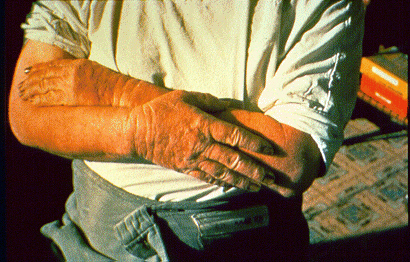Defatting (medical) on:
[Wikipedia]
[Google]
[Amazon]
Defatting is the chemical dissolving of dermal
 Defatting is caused by the exposure of human skin to a chemical substance, including alcohols, detergents, chemical
Defatting is caused by the exposure of human skin to a chemical substance, including alcohols, detergents, chemical
lipid
Lipids are a broad group of naturally-occurring molecules which includes fats, waxes, sterols, fat-soluble vitamins (such as vitamins A, D, E and K), monoglycerides, diglycerides, phospholipids, and others. The functions of lipids includ ...
s, from the skin
Skin is the layer of usually soft, flexible outer tissue covering the body of a vertebrate animal, with three main functions: protection, regulation, and sensation.
Other animal coverings, such as the arthropod exoskeleton, have different de ...
, on contact with defatting agents. This can result in water loss from the affected area and cause the whitening and drying of the skin which may result in cracking, secondary infection and chemical irritant contact dermatitis.
Cause
 Defatting is caused by the exposure of human skin to a chemical substance, including alcohols, detergents, chemical
Defatting is caused by the exposure of human skin to a chemical substance, including alcohols, detergents, chemical solvent
A solvent (s) (from the Latin '' solvō'', "loosen, untie, solve") is a substance that dissolves a solute, resulting in a solution. A solvent is usually a liquid but can also be a solid, a gas, or a supercritical fluid. Water is a solvent for ...
s and motor oil. Aliphatic compounds (commonly found in kerosene
Kerosene, paraffin, or lamp oil is a combustible hydrocarbon liquid which is derived from petroleum. It is widely used as a fuel in aviation as well as households. Its name derives from el, κηρός (''keros'') meaning "wax", and was regi ...
) cause defatting action, with lower-boiling point aliphatics having the greatest defatting action and therefore the most potential to cause dermatitis. Aromatic compounds, such as styrene
Styrene () is an organic compound with the chemical formula C6H5CH=CH2. This derivative of benzene is a colorless oily liquid, although aged samples can appear yellowish. The compound evaporates easily and has a sweet smell, although high concen ...
, also have a defatting capacity.
Prevention
Defatting can be prevented by wearing appropriate protective clothing such asgloves
A glove is a garment covering the hand. Gloves usually have separate sheaths or openings for each finger and the thumb.
If there is an opening but no (or a short) covering sheath for each finger they are called fingerless gloves. Fingerless glo ...
, lab coat
A white coat, also known as a laboratory coat or lab coat, is a knee-length overcoat or smock worn by professionals in the medical field or by those involved in laboratory work. The coat protects their street clothes and also serves as a simpl ...
s and aprons
An apron is a garment that is worn over other clothing to cover the front of the body. The word comes from old French ''napron'' meaning a small piece of cloth, however over time "a napron" became "an apron", through a linguistics process cal ...
when working regularly with defatting agents. Prolonged skin contact or chronic defatting of the skin increases the possibility for developing irritant contact dermatitis and has the potential to worsen pre-existing skin conditions. Patients with chronic dermatitis are advised to use non-irritating soaps
Soap is a surfactant cleaning compound used for personal or other cleaning.
Soap may also refer to:
Education
* Supplemental Offer and Acceptance Program, for medical students who were not initially matched with U.S. residencies by the National ...
and dishwashing liquid
Dishwashing liquid (or washing-up liquid in British English), also known as dishwashing soap, dish detergent, and dish soap is a detergent used to assist in dishwashing. It is usually a highly-foaming mixture of surfactants with low skin irr ...
s sparingly and to choose those with a neutral pH and minimal defatting capability.
References
{{Dermatitis and eczema Chemical safety